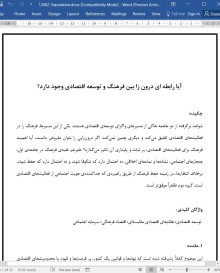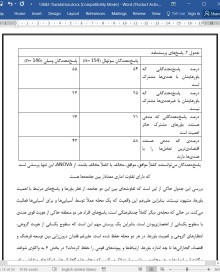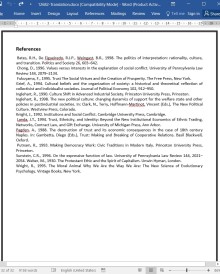
دانلود مقاله آیا رابطه ای درون زا بین فرهنگ و توسعه اقتصادی وجود دارد؟
چکیده
شواهد برگرفته از دو جامعه حاکی از مسیرهای واگرای توسعهی اقتصادی هستند. یکی از این مسیرها، فرهنگ را در فعالیتهای اقتصادی تلفیق میکند و دیگری چنین نمیکند. اگر درونزایی را نتوان مفروض دانست، آیا اهمیت فرهنگ برای فعالیتهای اقتصادی، بر ثبات و پایداری آن تاثیر میگذارد؟ علیرغم غلبهی فرهنگ در جامعهی اول، هنجارهای اجتماعی، نشانهها و نمادهای اخلاقی، نه احتمال دارد که شکوفا شوند و نه احتمال دارد که حفظ شوند. برخلاف انتظارها، در زمینه حفظ فرهنگ از طریق راهبردی که جداکنندهی هویت اجتماعی از فعالیتهای اقتصادی است، گروه دوم ظاهراً موفقتر است.
1. مقدمه
این موضوع کاملاً پذیرفته شده است که نهادها و قوانین یک کشور، بر فرصتها و قیود یا محدودیتهای اقتصادی تاثیر میگذارند. با تغییر رویهی کشورها و سوق یافتن آنها به سمت سرمایهداری دموکراتیک، دانشمندان علوم سیاسی و اقتصاددانها به مطالعهی مجدد نهادها و قوانینی پرداختند که در عین حالی که دموکراسی را تقویت میکنند، کارایی و رشد اقتصادی را نیز بیشینه سازند. چون رفتار با انتظارها مطابقت ندارد، توضیحات غالباً به رابطه درونزای بین فرهنگ و توسعه اقتصادی معطوف میشوند. در حالی که مشمول کردن فرهنگ در توسعه صحیح است، اما در زمینه لحاظ کردن آن در تحلیلها، باید ملاحظاتی دقیق صورت گیرد. امروزه ما ریسک میکنیم و فرهنگ را بعنوان مجموعهای فراگیر از عوامل در نظر میگیریم. این موج جدیدِ توجه به فرهنگ، این ریسک را در پی دارد که پاندول خطا از فقدان یا «جعبهی سیاه» فرهنگ به همهجاباشیِ آن سوق یابد و به همان اندازه که در تعامل و توسعه اقتصادی برای فرهنگ اهمیت قائل است، متأثر گردد.
به منظور اجتناب از پرداختن به فرهنگ بهمثابه یک توضیح باقیمانده و فرض اینکه فرهنگ به تمام توضیحات مرتبط است، توجه بیشتری باید به مشخصهی سازوکارهایی معطوف شود که فرهنگ بواسطهی آنها بر توسعهی سیاسی و اقتصادی تاثیر میگذارد. درونزایی، بیش از اینکه قطعیتی نظری باشد، پرسشی تجربی است و درک الگوها یا سازوکارهایی که فرهنگ را به عوامل اقتصادی مرتبط میسازند، در مطالعهی توسعه، حائز اهمیت است. در عین حال، اگر سازوکارها گوناگون باشند نه خود فرهنگها، امکانش هست که فراتر از قومیت هرکسی، آن را تعمیم داد. مقالهی حاضر بر درونزایی بین فرهنگ و توسعه اقتصادی تمرکز دارد اما تاکید علاوه بر اینکه بر سازوکارها است، بر مطالعات مربوط به درونزایی بین فرهنگ و توسعهی سیاسی نیز است.
9. نتیجه
این مقاله با مباحثهای نظری آغاز شد در اینباره که آیا رابطهای درونزا بین فرهنگ و توسعه اقتصادی وجود دارد یا خیر. تحقیق من میگوید که این مباحثه باید به سمت بررسی گوناگونی در رابطه درونزا سوق یابد نه به سمت فرض حضور یا عدمحضور این ارتباط. در سال 1999، کتاب «فرهنگ مهم است» بلحاظ نظری نتیجه گرفت که گوناگونی در ارزشهای فرهنگی و رفتار، با سطوح مختلف پیشرفت متناظر است. بنابراین راهحل تجربی برای کشورهای توسعهنیافته، ترویج تغییر فرهنگیِ پیشرو است. با اینحال پژوهش من با بررسی گروهها در بافتهای مختلف، مولفهای مهم از رابطه بین فرهنگ و توسعه را در سازوکارهای مختلفی نشان داده است که رابطه بین فرهنگ و فعالیتهای اقتصادی را تعریف میکند. برخلاف نتیجههایی که کتاب فرهنگ مهم است گرفته است، این سازوکارها هستند نه خصیصههای فرهنگی خاص که بر درونزایی فرهنگ و توسعهی اقتصادی تاثیر میگذارند.
مورد پنجابیها تفکیکی جغرافیایی ارائه میدهد از سازوکاری که تلفیق فرهنگ و فعالیتهای اقتصادی را حفظ میکند. از سوی دیگر، نهادیهسازی فرهنگ گجاراتیها، سازوکاری دیگر با تاثیر محدودسازی نقش فرهنگ در توسعه است. در ومبلی، فرهنگ از اهمیت محدودی برخوردار است و بعنوان بنیانی موقت جهت رشد کسبوکار در کوتاهمدت و بهعنوان تختهی پرشی برای گسترش به سایر حوزهها عمل کرده است. صاحبان کسبوکار، کسبوکارها را درون جامعهی قومی شروع میکنند اما سپس وقتی سرمایه تامین شد، با سرمایهگذاری در جایی دیگر و توسعهی مشتریان، فرصتها را توسعه میدهند. در مراحل اولیه، کارآفرینان وبملی با توسل به بازاری که گجاراتیها را جذب میکند، سرمایه لازم را بدست میآورند اما به محصولات مصرفی و الگوها محدود نیست. در مقابل، کسبوکارهای سوتهال، کالاهای مصرفی را جذب کردهاند اما قادر نبودهاند برای محلههای مجاورشان یا برای جمعیت فرهنگیِ محلیشان جذابیتآفرینی کنند. نشانههای توانمندی از رکود اقتصادی وجود دارد. هم خود مغازهها نیاز زیادی به روزآمد شدن دارند و هم تعداد جابجایی افراد شاغل آنقدر زیاد است که نمیتوان رشد بلندمدتی را ایجاد کرد. همانطور که در مثالهای قبلی اشاره کردیم، ظرف یک بازه زمانی 1 یا دو ساله، صاحب یک کسبوکار پوشاک حاضروآماده، تبدیل به صاحب مغازهی خردهفروشی پوشاک یا مغازهی لوازم آشپزخانه میشود و سپس وی ممکن است تبدیل به مدیر اموال اجارهای گردد. پنجابیها دلبستگیهای فرهنگیشان را پرورش دادهاند و در مراحل اولیه به نظر میرسد که این پیوندها سرمایهگذاری اولیه و روابط کسبوکار را تسهیل نمایند. اما در بلندمدت، این دلبستگیها مانع انباشت ضروریِ سود برای سرمایهگذاری، بسط محصولات جهت جذب مشتریهای غیرهندی و نیز اصلاح شیوههای سازگاری با غیرهندیها، قانونیکردن معاملههای تجاری جهت برقراری استانداردها و انتظارهای عینی، میشوند.
Abstract
Evidence from two communities suggests diverging paths of economic development; one which integrates culture into economic activities, and a second path which does not. If endogeneity cannot be assumed, does the relevance of culture for economic activities influence its stability and sustainability? Despite the predominance of culture in the former community, the social norms, ethnic cues and symbols are neither more likely to thrive or survive. Against expectations, the latter group appears more successful in preserving culture through a strategy of separating social identity from economic activities. © 2002 Elsevier Science B.V. All rights reserved.
1. Introduction
It is widely accepted that the institutions and laws of a country affect economic opportunities and constraints. With the explosion of countries making the transition to democratic capitalism, political scientists and economists renewed the study of institutions and laws which promote democracy at the same time as they maximize economic efficiency and growth. As behavior does not conform to expectations, explanations frequently turn to the endogenous relationship between culture and economic development. While including culture in development is the right direction there is cause for careful consideration of the way it is included in analyses. It used to be that culture was treated as a residual category simply filling in what could not be explained by other variables. Today, we risk placing culture as an omnipresent set of factors. This new wave of attention to culture carries the risk of pushing the pendulum of error from the absence or “black box” of culture to its ubiquity, and suffers to the extent that it assumes the relevance of culture for economic interaction and development.
To avoid treating culture as a residual explanation and assuming culture as relevant to all explanations, greater attention needs to be given to the specification of mechanisms by which culture interacts with political and economic development. Endogeneity is an empirical question rather than theoretical certainty and understanding the patterns, or mechanisms, which connect culture to economic factors is crucial for the study of development. At the same time, if it is the mechanisms which vary, rather than the cultures themselves, it may be possible to generalize beyond any one ethnicity. This paper focuses on the endogeneity between culture and economic development, but the emphasis on mechanisms applies similarly to studies of the endogeneity between culture and political development.
9. Conclusion
This paper began with the theoretical debate concerning whether or not there is an endogenous relationship between culture and economic development. My research suggests that the debate must shift towards studying variation in the endogenous relationship rather than assuming the presence or absence of the connection. In 1999, the edited volume of Culture Matters concluded theoretically that variation in cultural values and behavior corresponded with different levels of progress. The empirical solution for undeveloped countries, therefore, is the promotion of “progressive cultural change”. However, by examining groups in different contexts my study demonstrates that an important component of the relationship between culture and development is the various mechanisms which define the relationship between culture and economic activities. In contrast with the conclusions in Culture Matters, it is these mechanisms, rather than the characteristics of a particular culture, which affect the endogeneity of culture and economic development.
The Punjabi case presents geographic separation as one mechanism preserving the integration of culture and economic activities. On the other hand, the Gujaratis’ institutionalization of culture, is another mechanism with the effect of limiting the role of culture in development. In Wembley, culture is of limited relevance, and it served as a temporary foundation to cultivate business in the short run and as a springboard for expansion into other areas. Owners start up businesses within the ethnic community, but then once capital is established, they expand opportunities by investing elsewhere and developing a broader consumer base. In the early stages, Wembley entrepreneurs earn necessary capital by appealing to a market that captures Gujaratis, but is not limited to their consumption products or patterns. In contrast, Southall businesses have captured Punjabi consumption but they have been unable to develop appeal beyond the immediate neighborhood, or localized cultural population. There are strong signs of economic stagnation. Not only are the stores themselves in desperate need of renovation, but there is so much turnover that it is difficult to establish long terms growth. As cited in earlier examples, within a span of 1 or 2 years, an owner of a ready-made clothing store becomes an owner of a cloth retail store or kitchenware store and then he or she may become a property rental manager. Punjabis have cultivated their cultural attachments and in the early stages it seems that these bonds facilitate early investment and business relationships. In the long run, however, these attachments prevent the necessary accumulation of profit for reinvestment, expansion of products to attract non-Indian customers, adjustment of practices to accommodate non-Indians similarly, and the legalization of business deals to establish objective standards and expectations.
چکیده
1. مقدمه
2. پنجابیها در سوتهال لندن
3. گجاراتیها در ومبلی، لندن
4. روشها
5. پاسخهای پرسشنامه
6. حفظ فرهنگ از طریق جداسازی در مقابل نهادینهسازی
7. تفکیک پایداری فرهنگی و نهادینهسازی
8. بحث و تبادل نظر
9. نتیجه
منابع
Abstract
1. Introduction
2. The Punjabis in Southall, London
3. The Gujaratis in Wembley, London
4. Methods
5. Survey responses
6. Cultural preservation through segregation versus institutionalization
7. Cultural stability through segregation versus institutionalization
8. Discussion
9. Conclusion
References
- اصل مقاله انگلیسی با فرمت ورد (word) با قابلیت ویرایش
- ترجمه فارسی مقاله با فرمت ورد (word) با قابلیت ویرایش، بدون آرم سایت ای ترجمه
- ترجمه فارسی مقاله با فرمت pdf، بدون آرم سایت ای ترجمه



